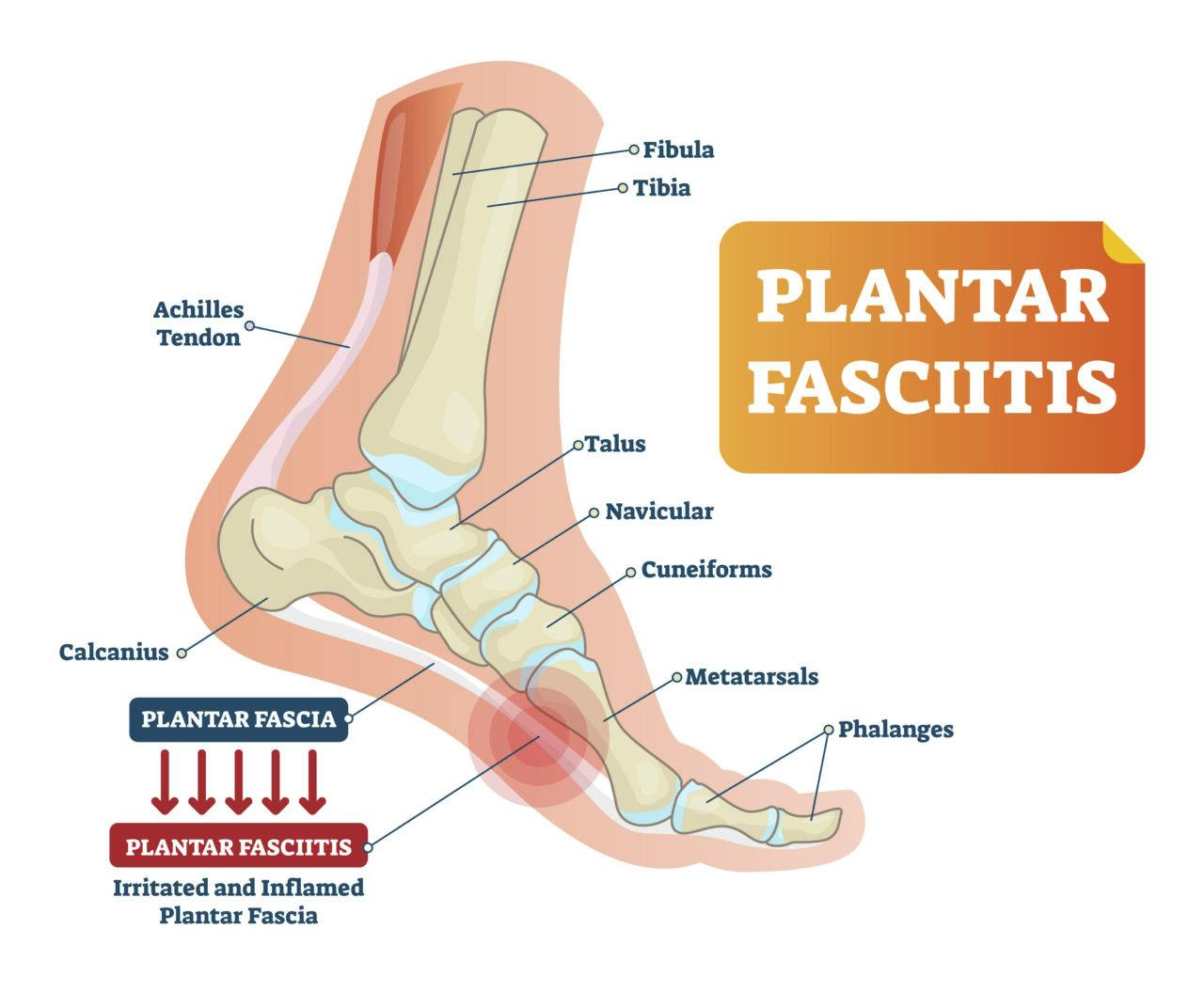Reading time: 5 minutes, 50 seconds
Foot pain from plantar fascitis is no joke. The good news is, non-invasive treatments are there for you.
Gabrielle Rose was a dancer, both classical and modern. Before rehearsals and performances, says Gabrielle, she was careful to stretch her feet, calves, and other muscles.
One hot summer in New York, Gabrielle began taking a morning walk to a nearby artisanal coffee bar, wearing her ballet flats. Not long after, she woke up with excruciating pain in her heel. Although the pain lessened somewhat during the day, it did not disappear and began to limit her career significantly.
Without her customary stretching, Gabrielle had developed a painful heel condition called plantar fascitis. PF is an overuse injury affecting people on their feet at work all day, as well as runners and other athletes and performers.
According to one podiatrist at UCLA, plantar fasciitis has reached epidemic proportions in the US. Some studies state that 10% of the population will suffer.
The good news is that, unlike conventional treatments of 20 years ago, non-interventional and personalized approaches are available.
Jump to:
Signs and Symptoms of Plantar Fasciitis
How Can a Physical Therapist Help?
Can plantar fasciitis be prevented?
The Importance of Early Treatment
Gabrielle was able to treat this condition before it became chronic, as is true with roughly 90% of the victims of PF.
And therein lies a lesson for heel pain sufferers.
The acute stage of plantar fasciitis normally lasts about six months, and can be treated as an inflammatory condition during that time. After that, the condition can become chronic, though still treatable, and with specialized techniques. 2.
While home remedies are tempting, and can work in some cases, a great deal of trouble can be saved by early professional treatment with an evidence-based team approach like that used at Park Sports Physical Therapy in conjunction with your podiatrist.

What is plantar fascitis
Plantar fasciitis is a soft tissue condition in the plantar fascia, a thick band of connective tissue in the foot. Its function is to absorb shock and to release stored energy during weight bearing cycle. The bony growths called heel spurs also seem to occur in about half the people suffering PF.
PF is not the only generator of heel pain, but it is right up there as a very major cause.
In its early stages PF is an inflammatory condition, causing swelling, stress and high levels of pain. The inflammation may be triggered by microtears due to the repetitive stress caused by standing for long periods and weight bearing. The inflamed area could occur in any or all sections touched by the facia. 2
However, according to Bob Baravarian, a Assistant Clinical Professor at the UCLA School of Medicine: “If the patient has had the problem for over six months, it is rarely an inflammatory condition any longer and more commonly a chronic scar formation with microtears of the fascia causing the pain.”
Two forms of plantar fascitis
So there appear to be (at least) two forms of plantar fasciitis, and that is one reason that your Park Sports Physical Therapist and your podiatrist will spend time exploring your symptom history with you, the length of time you have had the condition, as well as your lifestyle and other factors.
“One can divide plantar heel pain into an initial inflammatory problem we call plantar fasciitis, which is commonly present for the first three to six months, and a chronic non-inflammatory plantar fascia problem we call plantar fasciopathy,” according to Baravarian.

What can trigger PF?
For a runner, plantar fascitis could result from a training error such as running on hard surfaces or wearing improper footwear.
There are also intrinsic factors that can lead to a development of PF, even at the normal activity level. The structural factor most often implicated in plantar fasciitis is too much pronation- an excessive lowering of your foot arch to the ground during weight bearing. This puts an excessive tension on plantar fascia. (See our article on preventing show-stopper runner injuries, for more on Park Sports’ expertise in foot treatment).
Also contributing are obesity, weakness in the flexor muscles, tightness of the Achilles tendons and torsional rotation of the shin bone.
In sum, the risk factors for PF are as follows:
- Excessive body weight
- Prolonged standing
- Training errors by athletes
- Improper or worn-out footwear
- Excessive pronation
- High arch
Signs and Symptoms of Plantar Fasciitis
It’s hard to believe, but true, that during an typical day your feet absorb the same weight as carried by a loaded cement truck.
It’s no wonder that your feet are vulnerable to these and other conditions!
The syndrome is often brought about by a sudden increase in your physical activity, although sometimes by a change in lifestyle, or other physical issues.
These are the signs:
- Sharp pain at the bottom of the heel on weight rearing after prolonged rest, as in getting out of bed in the morning.
- Pain when start walking after sitting or standing
- Improvement in pain after 30-40 minutes of walking.
- Tenderness to touch at the bottom of your foot.
How Can a Physical Therapist Help?
While all physical therapists are trained to treat plantar fasciitis, look for board-certified therapists, and those who specialize in running and athletic injuries, as those are very common and provide expertise. The Park Sports staff is proud of its staff qualifications in both areas.
In advanced Physical Therapy, every effort is made to manage even chronic plantar fascitis with non-surgical methods. Park Sports Physical Therapists may opt to use evidence-based non-surgical management of Plantar Fasciitis in these main categories:
Addressing the pain and discomfort
- Iontophoresis
An advanced electronic delivery of pain medication without a needle. An example of Park Sports commitment to non-invasive therapies.
- Cryotherapy
Literally “cold therapy“ using the application of cold temperatures to reduce pain and treat injury. The treatment has been used by athletes for many years.
- Deep tissue massage
Massage has been found to have immediate and lasting benefit with PF when used in a skilled protocol, and over a period of time.
- Ultrasound
In chronic conditions, where scar tissue around microtears can be the main issue, a tiny probe is used to focus ultrasound and mitigate the scars. 5
Reduction of stress on the inflamed tissue
- Evaluation or changing footwear
Your therapist may suggest specific shoe models depending on your heel striking or or toe striking walking style. Worn out footwear should be discarded.
- Implementation of foot orthotics (inserts).
Your medical and Physical Therapy team may recommend a custom orthotic, while for some individuals, a commercial over-the-counter orthotic is just as effective.
- Foot strapping
Also known as low-Dye taping, a special tape is wrapped around your foot and ankle. This can help stabilize the plantar fascia and support your arch.
Restoring strength and flexibility of the muscles involved
-
- Strengthening all muscle groups involved in the support of the arch
- Developing a comprehensive stretching program
- Activity modification
The Park Sports personalized approach
Your foot contains fully 25% of all the bones in your body. Along with the supporting ligaments and tissue, your foot is one complex anatomical region.
As such, a plantar fasciitis condition has a great number of variants, depending on the individual, his or her physical condition and his or her lifestyle.
That is why your Park Sports physical therapist will spend time consulting with your podiatrist, and exploring your condition history. For example, depending on your lifestyle, your work, your daily habits, certain therapies may simply not be practical, even if they may be be beneficial. A Physical Therapist will find the treatments and exercises that are practical in your life.
Can plantar fasciitis be prevented?
Here are some steps that can help prevent plantar fasciitis. Runners should consider Park Sports’ Running Analysis for a more in-depth and individualized program of prevention.
- Sensible, supportive shoes are a must. Women wearing high heels should take extra precautions.
- Do not allow your shoes to wear out, as your feet will strike differently and incorrectly in worn out footwear.
- If your job requires you to stand in one place during the day, use a thick mat, or position 1 foot on a rail if available.
- Important: before exercising, be sure to always stretch calves, ankles, feet, and other muscles. Begin the stretching and warm-up slowly, and gradually work into a more intensive routine. A cool down exercise and stretching after a workout is highly recommended.
- Make sure you maintain a healthy body weight for your body type.
FAQ
What Is Plantar Fasciitis?
Plantar fasciitis is a soft tissue condition in the plantar fascia, a thick band of connective tissue in the foot. Its function is to absorb shock and to release stored energy during weight bearing cycle.
What is the fastest way to cure plantar fasciitis?
According to the Mayo Clinic, many “people who have plantar fasciitis recover in several months,” assuming assuming expert treatment.
The speed of a cure very much depends on the underlying trigger, your age, physical condition and other factors.
How can I tell if my plantar fasciitis is getting better?
As this condition heals, you should have less and less pain in the morning. Pain decreases over time — The pain of plantar fasciitis can take time to go away, but it should steadily decrease over time.
Can I treat plantar fasciitis at home?
If you are experiencing pain for many days, we believe it is best for you to consult your podiatrist, who may in turn refer you to a physical therapist. Home remedies include an ice pack on the painful spot, nonsteroidal anti-inflammatories like ibuprofen, very gentle stretching. But do keep in mind that if your PF develops into a chronic condition, while treatable, a cure could take some time.
What is the main cause of plantar fasciitis?
PF is an overuse injury, where a sudden increase in weight-bearing on the feet or other factors such as improper shoewear, causes inflammation.
Does plantar fasciitis go away on its own?
Some form of pain relief, stretching, and other interventions are normally needed.
.png?auto=format&auto=compress&h=150)